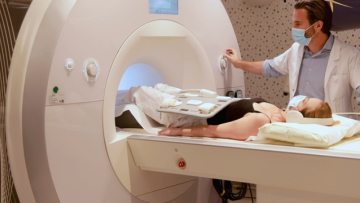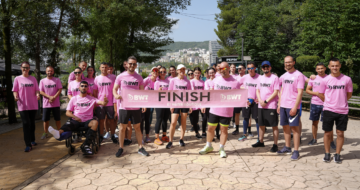International first: CT scan of bones without X-rays

Radiologists at Ghent University Hospital have succeeded in converting MRI images of bone structures into 3D CT images using advanced software. A breakthrough that could offer a solution for the dangerous X-ray radiation that is released when making classic CT images.
Radiologists at Ghent University Hospital have succeeded in converting MRI images of bone structures into 3D CT images using advanced software. A breakthrough that could offer a solution for the dangerous X-ray radiation that is released when making classic CT images.
Solution for bone injury diagnosis
Precise imaging is crucial to properly treat a bone injury. MRI scans use harmless radio waves, but are mainly suited for tissues such as muscles, and not for bone structures such as the back or hips. For these, a CT scan is unsurpassed, although this technique requires ionising X-rays.
Therefore, the company MRIguidance has developed software - called BoneMRI - which can convert MRI images to CT images in 3D. "Using artificial intelligence, we can now generate synthetic CT images of the bones of the back, the sacrum joints and the hips," explains Prof Jans. "It suffices to scan the patient for a few more minutes after the standard MRI. We transmit the MRI images to a server on our campus and an hour and a half later the synthetic CT images appear on our computer."
Dangerous radiation during CT scan
Every year, more than 2 million patients undergo CT scans in Belgium. Those scans use X-rays, which increase the risk of cancer. Prof. Jans: "We know how dangerous CT scans are. That's why we often don't carry them out in cases of bone injury. But consequently, we miss important information for a proper diagnosis and correct treatment. This new technique surpasses the disadvantages of the existing scans and is therefore very good news for our patients."
Double-blind research
The technique has been tested in recent months on patients with inflammatory rheumatism of the sacrum joints, Bechterew's disease. These are often young patients for whom early detection is important to avoid serious structural injuries later on. The results of conventional CT and synthetic CT were compared in a double-blind fashion and proved to be equally sensitive and specific. They scored much better than conventional MRI. The study was published in the journal Radiology.
Application in the UZ Gent
In the meantime, the technique has been adopted at UZ Gent for imaging the back, the sacrum joints and the hips. An estimated 500 patients a year will be able to undergo the new scan.
In the upcoming months, the team will continue to work on the examination of other bones that are preferably not exposed to RX-radiation, such as the entire spine.
Latest insights & stories

VERKEERSVEILIGHEID
Sinds 2018 is het aantal verkeersslachtoffers in Vlaanderen opnieuw gestegen. Momenteel stagneren de cijfers, maar het risico op ongevallen met letsels blijft groot voor kwetsbare weggebruikers in Vlaanderen. En dat terwijl het verkeer veilig moet zijn voor alle gebruikers en modi. We willen hier verandering in brengen door te focussen op transparant beleid, trainingen rond veilig gedrag, infrastructurele verbeteringen, wetgeving en handhaving.

Wat is er nodig voor een meer circulaire bouwsector? Inzichten van Sien Cornillie, expert circulariteit bij NAV
NAV, of "Netwerk Architecten Vlaanderen," is een professionele organisatie voor architecten in Vlaanderen. Ze biedt diverse diensten aan, waaronder professionele ontwikkeling en belangenbehartiging voor architecten. Daarnaast bevordert NAV ook netwerkmogelijkheden en geeft het advies over juridische, technische en managementaspecten. Het netwerk werkt momenteel aan een standpuntennota rond circulariteit. We spraken met Sien Cornillie, expert circulariteit bij NAV, die in dit interview uit eigen naam spreekt.

A Global Movement: The World Unites in a Pink Pledge for Clean and Sustainable Water
5,000 participants. 32 countries. €30,000 funds raised. And that's just the beginning.
Picture this: One step that sends ripples across the globe, transforming lives and creating waves of change. You might wonder, how can such a simple action for most of us have such a profound impact?